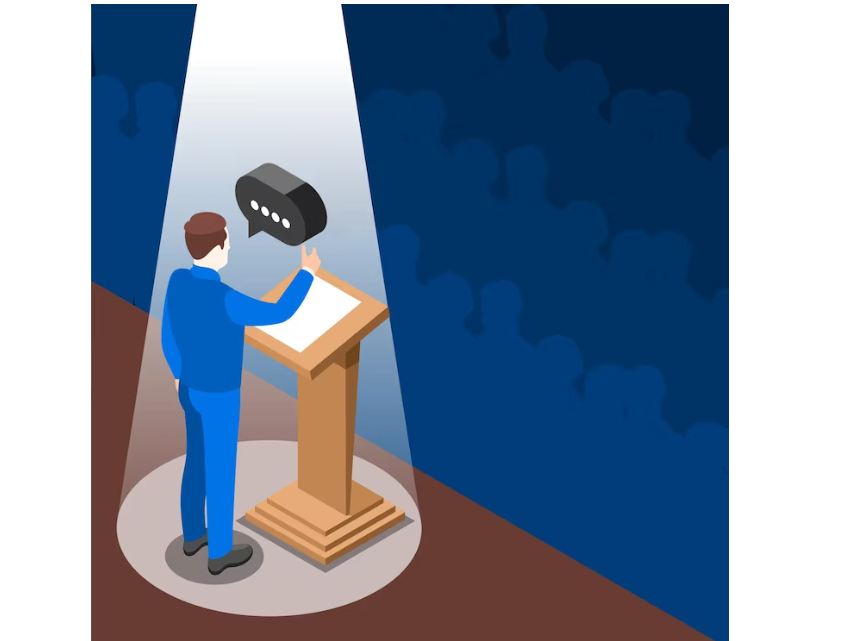
Public speaking is an art that requires consistent and regular practice to master. It requires the speaker to use persuasive language to engage and influence the audience. How good of a speaker one is depends on the speech’s content and delivery. That is when mastering a few persuasive techniques is helpful for any public speaker.
Persuasive techniques help speakers to enrapture the audience and hold their attention. One can use persuasive techniques to convince the audience to opt for a particular course of action, alter their beliefs, or nudge them to decide.
More often than not, one’s public speaking engagement success depends on the speaker’s ability to use persuasive techniques. That’s why mastering the art of persuasive techniques is crucial for those who want to deliver a powerful and effective speech.
17 Key Persuasive Techniques to Become a Proficient Public Speaker
Persuasive techniques in public speaking include rhetoric, emotions, and facts, among others, to make an argument more compelling. A skilled public speaker will use these techniques to establish credibility and convey their message.
While you can learn more about the different public speaking techniques in our article, “Speak with Impact: 13 Public Speaking Techniques to Leave a Lasting Impression“, take a look at our list of 17 sure-shot persuasive techniques that will surely transform you into a master public speaker.
1. Ethos
Ethos is a public speaking technique that relies on the credibility and authority of the speaker to persuade the audience. To use ethos in public speaking, a speaker must convince their audience that they are a reliable and informed source.
They can showcase ethos by sharing personal stories that prove their connection to the topic. This way, the speaker can build trust with their audience and increase the likelihood.

Pic Courtesy: Freepik
For example, a doctor giving a speech on a medical topic may use ethos by highlighting their qualifications and years of experience in the field. A CEO speaking at a business conference may use ethos by referencing the company’s success and leadership track record.
Additionally, a speaker can use ethos to build rapport with the audience. For instance, a public figure or celebrity may use ethos by sharing personal stories or experiences that the audience can relate to.
Here are some ways in which ethos can be a persuasive technique:
- Establishing credibility: Ethos helps establish the speaker’s credibility and expertise. Speakers can influence the audience with their credibility. The speaker can establish credibility through personal credentials or references to recognized authorities in the field.
- Building trust: Ethos plays a significant role in building trust between the speaker and the audience. When the audience trusts the speaker, they are more open to accepting their viewpoint or proposal. Consistent and reliable communication can help develop confidence.
- Appealing to shared values: One can enhance ethos by aligning the speaker’s message with the audience’s values and beliefs. Emphasizing a common ground can help the speakers prove that they understand the audience’s perspective. This shared value system strengthens ethos’s persuasive impact.
- Presenting logical reasoning: Speakers can reinforce by giving logical reasoning and a well-structured argument. Showcasing a clear thought process can help speakers prove their ability to analyze information. This logical appeal enhances the speaker’s credibility and persuasiveness.
2. Pathos
Pathos is the use of emotions to persuade an audience. It connects with people’s values and feelings, making the speaker relatable and trustworthy. It helps establish an emotional connection, making listeners pay attention to them.
Emotions can motivate action and inspire people to support causes or change behavior. It’s essential to use pathos without manipulating emotions.

Pic Courtesy: Freepik
For instance, a politician uses pathos to assure the audience that he cares for his community.
Here are some ways in which pathos can be a persuasive technique:
- Emotional engagement: Pathos aims to connect with the audience by appealing to their desires, fears, aspirations, or values. Speakers evoke emotions like empathy, compassion, joy, anger, or fear to establish a strong bond with the audience. This emotional engagement increases the audience’s receptiveness to the message.
- Relatability: Pathos uses relatable situations or stories that connect with the audience’s experiences and emotions. When the audience sees themselves or people they care about in the narrative, they become more invested in the message. This relatability strengthens the persuasive impact of pathos.
- Storytelling: Pathos often utilizes storytelling techniques to create emotional impact. Stories transport the audience into a different world.
- Empathy and compassion: Pathos can be persuasive by appealing to the audience’s sense of empathy and compassion. Highlighting the suffering, challenges, or needs of others can help speakers trigger the audience’s empathy and motivate them to take action.
- Using vivid language and imagery: Pathos employs vivid language and imagery to evoke strong emotions. Using descriptive words, metaphors, or visual cues can help speakers influence the audience. This imagery enhances the persuasive impact of pathos.
- Addressing values and beliefs: Pathos can be persuasive by aligning the message with the audience’s values and views. When the message aligns with the audience’s core values, they will trust the speaker.
3. Logos
The term “logos” originates from the Greek word for “word” or “reason.” Logos appeal to the audience’s sense of reason and logic by using facts, statistics, and arguments. It refers to using logical reasoning, evidence, and points to persuade an audience or make an argument more convincing.
When employing logos, the goal is to present a logical and rational case that appeals to the audience’s intellect and ability to reason.

In persuasive communication, one can achieve logos through several means:
- Evidence and Data: It involves presenting factual information, statistics, research findings, and expert opinions to support an argument. It includes citing reliable sources, studies, surveys, and other empirical evidence.
- Logical Reasoning involves employing deductive or inductive reasoning to prove a logical progression of ideas. It includes using premises and evidence to reach a valid conclusion. Deductive reasoning starts with general principles and moves to specific findings, while inductive reasoning begins with detailed observations and moves toward broader generalizations.
- Cause and Effect: It can help predict the likely consequences of certain actions.
- Analogies and Comparisons: Drawing parallels between similar situations or concepts to help the audience understand a complex argument.
- Logical Fallacies: Recognizing and avoiding logical fallacies can undermine an argument’s strength. Examples of logical fallacies include ad hominem attacks (attacking a person instead of their opinion), straw man arguments (misrepresenting an opponent’s position), or false dichotomies (presenting only two options when more exist).
4. Appeal to Authority
“Appeal to authority” involves referencing an authority figure or expert in a particular field to support an argument or claim.

It relies on the idea that if an expert or respected figure endorses a position or statement, it is more likely to be valid and persuasive to the audience. The authority figure may have specialized knowledge, expertise, or experience that lends credibility to their opinion.
Here’s how appeal to authority functions as a persuasive technique:
- Credibility: The assumption is that the authority figure is knowledgeable and reliable in their field. Thus, their endorsement adds weight to the argument.
- Expertise: Authorities are often individuals who have achieved a high level of expertise or specialization in a particular subject. Citing their expertise in the speech can leverage the authority’s knowledge to support their argument.
- Social Proof: People tend to look to authority figures for guidance and validation. When an authority endorses a position, it can create a sense of social proof. It suggests that many others in the field or domain agree with the argument, which can influence the audience’s perception and make them more likely to accept the viewpoint.
However, it is essential to use the appeal to authority technique carefully. Here are a couple of considerations:
- Relevance: The authority cited should be relevant to the topic. The authority’s expertise and knowledge should relate to the argument. The appeal to authority may be fallacious if the connection needs to be stronger or more relevant.
- Context: It’s essential to consider the context and the range of expert opinions within a field. Authorities can disagree on some issues. Appealing to one authority may overlook alternative viewpoints or conflicting evidence. It is wise to present a balanced view by acknowledging many sources or providing a range of perspectives.
5. Appeal to Tradition
Appealing to tradition can tap into people’s reverence for established customs, practices, and beliefs. When speakers reference traditions, they create a sense of familiarity, stability, and legitimacy around their arguments or proposals.

Here are a few reasons why appealing to tradition can be effective:
- Emotional connection: Traditions often evoke strong emotions and sentiments in people. Speakers can tap into individuals’ emotional attachment toward their cultural heritage or long-standing practices by appealing to familiar traditions. This emotional connection can build rapport and create a sense of shared identity between the speaker and the audience.
- Perceived wisdom: Traditions are often repositories of accumulated knowledge and experience. When a speaker references tradition, they can imply that the ideas or practices associated with it have stood the test of time. It can lend credibility to the speaker’s arguments and make them appear more trustworthy and knowledgeable.
- Stability and continuity: Tradition is often associated with stability, continuity, and order. Appealing to tradition can help speakers present their ideas in a way that preserves or restores established norms. It can be particularly effective when addressing an audience resistant to change.
- Social cohesion: Traditions can play a significant role in fostering a sense of belonging and community. When speakers appeal to tradition, they can emphasize the shared values, rituals, or customs that bind a group together. It helps create a sense of unity and cohesion within the audience, making them more receptive to the speaker’s message.
However, it is essential to note that while appealing to tradition can be persuasive, it is only sometimes a valid or logical argument. Speakers should use their discretion.
6. Appeal to Common Sense
It allows speakers to tap into shared beliefs, intuitive reasoning, and practical knowledge. Presenting arguments or ideas as “common sense” can help speakers create a sense of credibility.
Here are a few reasons why appealing to common sense can be effective:

- Accessibility: Common sense is primary, and everyday knowledge is accessible to everyone. Framing arguments as common sense helps speakers make their ideas more relatable, overcome comprehension barriers, and engage listeners who need more specialized knowledge or expertise.
- Agreement and consensus: When speakers appeal to common sense, they tap into shared beliefs or ideas of a community. It can foster a feeling of validation and make the listeners more receptive to the speaker’s message.
- Logical coherence: Common sense is often associated with logical reasoning and practicality. It can strengthen a message’s persuasiveness. Listeners are more likely to accept ideas that appear rational and align with their intuitive reasoning.
- Emotional resonance: Appeals to common sense often tap into people’s emotions. Presenting arguments as common sense helps speakers evoke many emotions. This emotional resonance can create a connection between the speaker and the audience and make the listeners more inclined to accept the speaker’s viewpoint.
7. Repetition
Repeating a key point or phrase throughout a speech reinforces its importance and makes it more memorable. Repetition is an essential persuasive technique in public speaking for several reasons:

- Reinforcement: Repetition helps reinforce critical points or messages. Repeating important ideas or phrases increases the likelihood that your audience will remember them, driving home the main points of your speech and making them more memorable.
- Emphasis: Repetition can help emphasize particular ideas or arguments. Repeating a phrase or a word can help speakers draw attention to it and signal its significance. It can help create a sense of importance and urgency in the minds of your listeners.
- Clarity: Repetition can enhance clarity and understanding. Complex ideas or concepts sometimes need repetition to ensure the audience comprehends them. Repeating information can help speakers give listeners more opportunities to grasp the content of their speech.
- Persuasion through familiarity: Repetition can create understanding and build rapport with the audience. When you repeat a phrase, it becomes more familiar to the listeners, leading to a sense of trust. As a result, the duplicated message may be more persuasive because it has become more comfortable and familiar to the audience.
- Emotional impact: Repetition can profoundly affect the audience. Repeating emotionally charged words or phrases can evoke strong emotions. It can be effective in rallying support, inspiring action, or generating enthusiasm among the listeners.
8. Rhetorical Questions
Rhetorical questions are an essential persuasive technique in public speaking. They help engage the audience, provoke thought, and encourage active participation. When posed with a rhetorical question, the speaker doesn’t expect a direct answer. Instead, these questions aim to make the audience reflect on the implied solution or consider a particular viewpoint.

Here are some reasons why rhetorical questions are practical in persuasive public speaking:
- Capturing attention: Rhetorical questions create curiosity and grab the audience’s attention. When a speaker poses a thought-provoking question, it encourages listeners to focus on the topic and become more engaged in the speech.
- Stimulating critical thinking: Rhetorical questions encourage the audience to think and reflect on their beliefs, attitudes, and experiences. These questions prompt self-reflection and enable listeners to develop a deeper understanding of the speaker’s argument and consider alternative perspectives.
- Establishing rapport: When listeners feel involved in the speech through rhetorical questioning, they will feel a personal connection to the speaker.
- Emphasizing key points: Rhetorical questions can emphasize essential topics in a speech. Asking a question, the speaker directs the audience’s attention to the significance of that point.
- Building anticipation: Rhetorical questions can create suspense and a logical progression of ideas. Asking a question helps the audience become eager to hear the speaker’s response or explanation.
- Overcoming resistance: Posing a question that challenges a common misconception helps the speaker guide the audience toward accepting their perspective without outright confrontation.
- Adding rhetorical flair: Well-crafted rhetorical questions can enhance a speech’s persuasive appeal and make the lesson more memorable.
9. Analogy
Public speakers make use of analogies in their speeches to illustrate a point. Comparing something complex to something straightforward can help the audience understand the concept better.

Pic Courtesy: Freepik
Analogies can be effective persuasive techniques in public speaking for several reasons:
- Simplifying complex ideas: Analogies allow speakers to streamline complex or abstract concepts. Using an analogy helps speakers break down complex ideas into simpler terms. This helps make the message more accessible and relatable to the audience.
- Enhancing comprehension: When a speaker uses an analogy, it provides a frame of reference that aids in understanding and comprehending the matter. It allows the audience to bridge the gap between what they already know and the presented concept.
- Creating emotional connection: Analogies can evoke emotions in the audience, making them more receptive. Comparing a situation to something emotionally charged helps the speakers tap into the audience’s emotions.
- Making ideas memorable: Analogies often use vivid imagery or storytelling. This makes ideas more special for the audience. Speakers use analogies to create mental associations between the metaphor and concept. This association helps the audience retain and recall the information long after the speech.
- Overcoming resistance or objections: Analogies can be powerful tools for addressing complaints or overcoming opposition from the audience. Analogies offer a different perspective to help the audience see the issue from a new angle.
- Building rapport and credibility: Speakers who use analogies that resonate with the audience’s lives or values demonstrate empathy and establish a connection. This connection enhances the speaker’s credibility and trustworthiness.
10. Metaphor
Many call metaphor a connection or bridge between the new and the familiar to better explain a complex concept or idea to the audience/listener. According to the dictionary, a metaphor implies comparing two unlike things.
For instance, “Memories are bullets. Some whiz by and only spook you. Others tear you open and leave you in pieces.” In this sentence from Kill the Dead, Richard Kadrey, memories are being compared to bullets. The metaphorical reference helps readers identify and resonate with certain emotions or experiences.
Metaphors can be effective persuasive techniques in public speaking for several reasons:
- Visual and sensory language: Metaphors can help speakers create a graphic mental image or evoke sensory experiences in the audience. This visual and sensory language captures the audience’s attention, engages their imagination, and makes the message more memorable.
- Emotional appeal: Metaphors often carry emotional connotations or associations, allowing speakers to tap into the audience’s emotions. This emotional appeal enhances the persuasive impact of the speech.
- Simplifying complex ideas: Similar to analogies, metaphors help simplify complex ideas by comparing the concept to something more familiar or relatable. Metaphors provide a tangible frame of reference that makes abstract concepts easier to understand.
- Memorable and engaging storytelling: Speakers use metaphors to tell stories or narratives, helping to create a captivating experience for the audience. Stories have a natural structure and emotional resonance that can captivate attention, help sustain interest, and make the message more compelling and memorable.
- Persuasive impact through association: Metaphors can leverage the power of association to influence the audience’s understanding of a topic. This association can shape how the audience interprets and evaluates the information.
- Bridging cultural or conceptual gaps: Metaphors can be particularly effective when speaking to diverse audiences. Metaphors can bridge gaps by using familiar symbols or references that transcend cultural or linguistic boundaries.
When used well, metaphors can capture the audience’s attention, resonate with their emotions, enhance understanding, and persuade them to adopt the speaker’s perspective or take the desired action.
11. Humour
Public speakers can use humor to engage the audience and make their message more memorable. Here are some tips on how to use humor in your speeches:

- Know your audience: Understand your audience’s preferences, values, and cultural backgrounds. Tailor your humor to their sensibilities, avoiding any offensive or controversial topics.
- Be authentic: Use humor that reflects your personality and style. Authenticity helps establish a connection with the audience and makes your humor more relatable.
- Start with a strong opening: Begin your speech with a well-crafted humorous anecdote or a witty remark. These tactics will help grab your audience’s attention from the start, set a positive tone, and make people more receptive to your message.
- Use appropriate jokes and anecdotes: Incorporate relevant jokes, stories, or anecdotes that align with your topic. Make sure they serve a purpose and support your key points. Analogies and metaphors can inject humor while making your message more relatable.
- Timing is crucial: Deliver your humor appropriately to maximize its impact. Use pauses to allow the audience to react and laugh, and avoid rushing through your punchlines or jokes.
- Self-deprecating humor: Light-hearted self-deprecating humor can build rapport with your audience and show humility. However, be careful not to undermine your credibility or come across as insecure.
- Use visual aids: Incorporate humorous visuals into your presentation slides or handouts. Visual humor can enhance the impact of your message and make it more memorable.
- Practice and refine: Test your humor with small audiences or trusted friends before delivering it to a larger crowd. Pay attention to their reactions and refine your jokes or delivery based on their feedback.
- Avoid offensive or divisive humor: Avoid jokes that could offend or alienate your audience. Also, avoid sensitive topics, controversial issues, or anything that could create discomfort or awkwardness.
- Balance humor with your main message: While humor can be persuasive, remember that your speech’s primary goal is to deliver a message. Ensure that your humor is consistent with your main points. Maintain a balance between entertainment and the substance of your speech.
Remember that not all situations require humor. You must gauge the appropriateness of humour based on the context, subject matter, and tone you want to set. Use humor to enhance your persuasive impact.
12. Emphasis
Public speakers can use vocal emphasis, hand gestures, or body language to emphasize a critical point and make it more memorable. Emphasis involves highlighting certain words, phrases, or ideas to make them stand out and create a lasting impression.

Here are some ways you can use emphasis in your public speaking to persuade your audience:
- Vocal Variety: Adjust your tone, volume, and speed of speech to emphasize important points. Use a louder voice or a slower pace to draw attention to key concepts. Soften your voice or speed up to create contrast and emphasize a change or surprising idea.
- Pause: Strategic pauses can enhance emphasis by allowing the audience to reflect on what you said. After delivering a crucial point, pause to give your listeners a moment to absorb and process the information. It can create a sense of anticipation and make your message more impactful.
- Repetition: Repeating a word or phrase can emphasize its significance and help reinforce your message. Use this technique to avoid sounding monotonous. Repetition can create a rhythmic effect and make your point more memorable.
- Gesture and Body Language: Accompany your words with appropriate gestures and body language to amplify the emphasis. Use hand movements, facial expressions, and body posture to highlight key ideas. For example, you can raise your hand or extend your arms when emphasizing a crucial point.
- Contrast and Comparison: Emphasize your message by contrasting ideas or scenarios. This technique can help your audience understand the value and uniqueness of your argument.
- Visual Aids: Incorporate visual aids such as charts, graphs, or images that complement your speech. In your presentation slides, emphasize essential data or critical points by using bold fonts, colours, or highlighting techniques. Visual elements can enhance the impact of your message and make it more persuasive.
- Rhetorical Devices: Utilize rhetorical devices such as metaphors, similes, or analogies to create vivid imagery and emphasize your ideas. These devices engage the audience’s imagination, making your message more relatable and memorable.
13. Hyperbole
Public speakers may sometimes use exaggerated language to make a point or garner the audience’s attention.

Pic Courtesy: Freepik
Hyperbole is a significant persuasive technique because it involves exaggeration for dramatic effect. Stretching the truth or magnifying a particular aspect of a situation with hyperbole can help capture the audience’s attention.
Here are a few reasons why hyperbole is impactful in persuasion:
- Attention-grabbing: Hyperbolic statements are often attention-grabbing because they stand out from everyday language. Hyperbole can immediately capture the listener’s attention.
- Memorable: Exaggeration tends to stick in people’s minds. Hyperbole can make a public speaker’s message more memorable and increase the chances of people agreeing with the argument. Its vivid and larger-than-life nature can leave a lasting impression.
- Emotional appeal: Hyperbole helps to evoke strong emotions and create a sense of urgency or intensity. Amplifying a situation’s impact or consequences with hyperbole can help stir up emotions among the audience. This emotional response can motivate the audience to take action or align with the speaker’s viewpoint.
- Emphasizing key points: When one exaggerates a decision’s positive or negative consequences, the speaker can draw attention to specific points.
- Persuasive effect: Hyperbole can be an effective tool in itself. Persuasive communicators can create a sense of credibility or expertise. Hyperbole implies that the situation is so extreme that only a unique solution or perspective can address it.
14. Storytelling
Storytelling creates emotional connections, enhances memorability, clarifies complex ideas, overcomes resistance, builds trust, and inspires action. Speakers can use storytelling to engage and persuade their audience.

Pic Courtesy: Freepik
Storytelling is a powerful and essential persuasive speaking technique for several reasons:
- Emotional connection: Stories can evoke emotions in listeners. Sharing a compelling narrative can help speakers tap into the audience’s emotions. It can help create a deeper connection and empathy. Speakers can persuade people with constant emotional engagement.
- Memorable and engaging: Humans tend to respond to stories. Unlike facts and statistics, which people forget, stories have a lasting impact on our memory. Speakers who incorporate storytelling into their presentations make their message more memorable, enhancing the audience’s attention and retention of the information.
- Illustrating concepts and ideas: Storytelling allows speakers to explain complex ideas or concepts in a more relatable way. With the right characters, settings, and plots, speakers can understandably present abstract or technical information. Stories provide context and vivid imagery, making the message more concrete and tangible.
- Overcoming resistance: When trying to persuade an audience, there may be resistance or skepticism toward the speaker’s message. Storytelling, through real-life examples, personal experiences, or testimonials, helps to address these barriers.
- Inspiring action: Stories have the power to inspire and drive people to action. Presenting stories with compelling characters, conflicts, and resolutions helps speakers create a sense of urgency. It also helps inspire empathy and mobilize the audience toward the desired outcome.
15. Inclusive Language
Inclusive language is a compelling speaking technique that fosters a sense of belonging. It also helps build credibility and trust, increasing relatability and connection. It challenges biases, encourages empathy and understanding, and demonstrates social awareness.

Pic Courtesy: Freepik
Employing inclusive language can help speakers create an inclusive and welcoming environment and influence the audience’s perception and reception of their message.
Inclusive language is a compelling, persuasive speaking technique for several reasons:
- Fostering a sense of belonging: Inclusive language acknowledges and respects the audience’s diversity. Using inclusive pronouns, avoiding gendered or biased language, and being mindful of cultural sensitivities can help speakers create an environment where everyone feels valued and included. It fosters a sense of belonging, enhancing the audience’s receptiveness to the speaker’s message.
- Increasing relatability and connection: Inclusive language allows speakers to connect with a broader range of individuals. When individuals feel seen and represented in the speaker’s message, they are more likely to engage with the content.
- Overcoming biases and preconceptions: Language can shape perceptions and reinforce biases. Using inclusive language can help speakers challenge stereotypes and prejudices within the audience.
- Encouraging empathy and understanding: When speakers use inclusive language to tell stories or present examples, they bridge gaps of understanding and create opportunities for empathy.
- Demonstrating social awareness and responsibility: Inclusive language reflects a speaker’s commitment to social awareness and responsibility. Choosing words and phrases that are respectful and inclusive helps speakers show their understanding of societal issues. It also shows their dedication to promoting equality and fairness. This can enhance the speaker’s credibility and appeal to the audience’s values.
16. Call to Action
The effectiveness of a call to action depends on other factors, such as the speaker’s credibility, the topic’s relevance to the audience, and the structure and delivery of the speech.

Here are a few ways in which a call to action can be persuasive:
- Directness: A call to action provides clear and direct instruction to the audience about what they should do next. The speaker eliminates ambiguity and makes it easier for the listeners to understand with a CTA.
- Clarity of purpose: A well-crafted call to action communicates the purpose and goal of the speech. It highlights the benefits or positive outcomes of the suggested activity. This makes it more appealing and persuasive to the audience.
- Emotional appeal: A call to action can tap into the audience’s emotions, evoking excitement, urgency, or empathy. Connecting the action with emotions can help speakers create a sense of motivation. It can also create a drive within the listeners, increasing the likelihood of them responding to the call.
- Sense of empowerment: A solid call to action empowers the audience by making them feel that their efforts can make a difference.
- Repetition and reinforcement: A persuasive speaker may repeat and reinforce the call to action throughout the speech, leaving a solid impression on the audience.
- Visual imagery and storytelling: A speaker can use a call to action to make his argument more persuasive by incorporating vivid imagery or storytelling techniques. This way, the speaker can captivate the audience’s attention, making the call to action more memorable and persuasive.
17. Appeal to Self-Interest
The Appeal to Self-Interest aims to convince individuals by demonstrating how a particular action, idea, or proposition is beneficial to their self-interests. It is based on the premise that people are generally motivated by their needs, desires, and well-being.
Here are some reasons why the Appeal to Self-Interest is an important persuasive technique:

Pic Courtesy: Freepik
- Relevance: The Appeal to Self-Interest directly addresses individuals’ concerns and priorities. When speakers highlight the specific benefits or advantages that can be gained by accepting the proposition, it becomes more relevant and meaningful to the audience. This increases the likelihood of their engagement and willingness to consider the persuasive message.
- Motivation: People are naturally inclined to take actions that serve their self-interests. The appeal to self-interest can help tap into this intrinsic motivation by aligning a proposition with their desires, aspirations, or needs. It provides a clear incentive for individuals to act as they perceive it as advantageous or beneficial to their well-being.
- Personalization: This technique allows the persuasive message to be tailored to individual preferences and circumstances. Understanding the unique needs and concerns of the audience can help speakers craft their arguments and present information that directly appeals to their self-interests. This personalization creates a stronger connection and resonance with the listeners.
- Overcoming resistance: People are often skeptical and resistant to ideas that seem like they need to be more directly relevant or beneficial to them. The Appeal to Self-Interest helps overcome this resistance by presenting a clear case for how the proposition addresses their specific needs or solves their problems. Demonstrating personal value or advantages reduces skepticism and increases the chances of acceptance.
- Emotional engagement: The Appeal to Self-Interest can evoke emotions such as excitement, satisfaction, or security by highlighting the positive outcomes that can be achieved. When individuals feel emotionally engaged and connected to a proposition, they are more likely to be persuaded by it. The persuasive message resonates with their desires and aspirations, triggering a positive emotional response that supports their decision-making process.
- Practicality and applicability: Focusing on self-interest’s persuasive message becomes more practical and applicable to individuals’ daily lives. It emphasizes the immediate and tangible benefits that can be obtained, making the proposition appear more realistic and achievable. This increases the persuasiveness of the message by showing individuals how it can make a concrete difference in their lives.
Key Takeaway
Persuasive techniques combine rational appeal, emotional connection, and ethical credibility. Crafted arguments can engage emotions and build trust with the audience. Using a variety of persuasive techniques in the right way empowers individuals to communicate. It also inspires action and achieves desired outcomes.
Public speaking can be intimidating, but mastering the right techniques can transform it into a potent tool for leaving a lasting impact on your audience. Whether you’re seeking a speaker or are one yourself, look no further than Gazebo—Speaker Directory by Eventible. With Eventible’s Gazebo Speaker Directory, you can discover passionate and seasoned public speakers who can deliver remarkable speeches at your upcoming event.
If you’re a speaker eager to establish your presence on Eventible’s Gazebo Speaker Directory, complete this convenient Google form. Take advantage of the opportunity to showcase your expertise and connect with a wider audience.





Comments are closed.